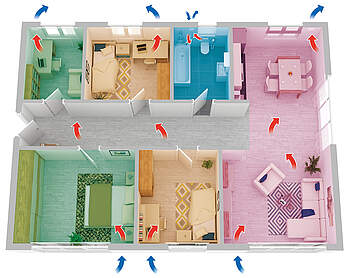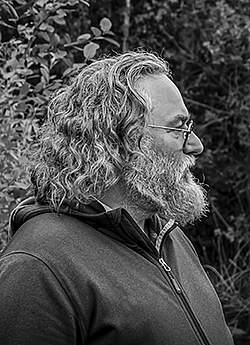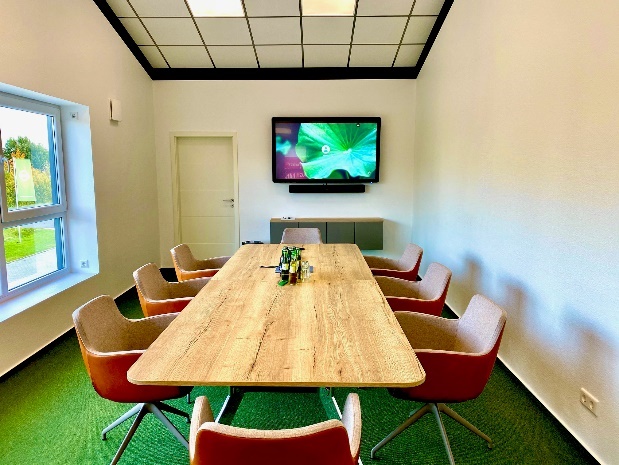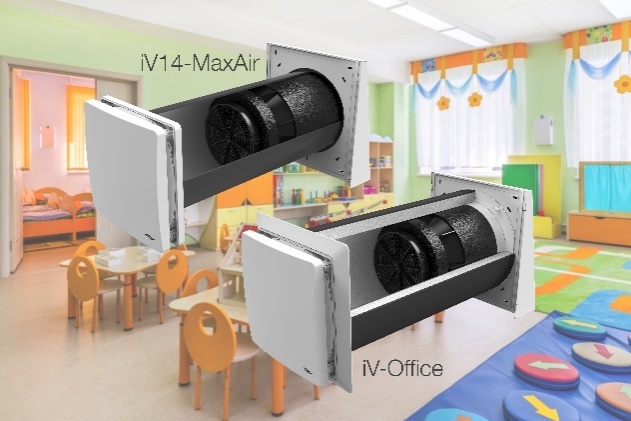Ventilation planning is more demanding today than ever: With the corona pandemic, the demands on hygienic indoor air, which should keep the risk of infection as low as possible, are increasing. Due to the contact restrictions, the training opportunities for specialist planners and energy consultants have also changed. And last but not least, the new Building Energy Act (GEG) will come into force in November 2020, which will replace the three energy saving regulations EnEV, EnEG and EEWärmeG. Energy consultant and training expert Joachim Schrader from BAUEN + ENERGIE comments on these current challenges in ventilation planning.

Question 1: Why is regular ventilation particularly important during the corona pandemic?
A regular supply of fresh air is an extremely important means of minimizing infections and contagions, along with other hygiene rules such as keeping your distance, wearing mouth and nose protection, washing and disinfecting your hands. All studies published so far show that regular ventilation reduces the risk of infection. The federal government has now also added ventilation to the well-known AHA rule. According to many virologists, the aerosol concentration in the air is an important factor for the spread of viruses and a cause of an increased risk of infection. Which means that ventilation systems are urgently needed in kindergartens, schools, open-plan offices, etc. Superspreader events clearly show that a single corona infected person is sufficient to infect a large group of people in poorly ventilated buildings.

As one of the heads of the BAUEN + ENERGIE work group, Joachim Schrader has been dedicated to resource-saving and ecological construction + renovation for over 25 years. With the common goal of advancing climate protection in building too, he regularly holds training courses for architects, energy consultants and specialist planners.

Question 2: In winter and in the transitional periods, however, the rooms cool down quickly if there is a lot of manual ventilation. What advantages does controlled living space ventilation offer here?
Let’s take up the much discussed topic of “schools”. Since classrooms are heated in autumn and winter and are, so to speak, constantly “reheated” due to the large number of learners in a relatively small space, a ventilation system with a high degree of heat recovery is ideal here. The heat that would be lost by ventilating the window is here, specifically using the example of the decentralized ventilation device inVENTer iV14-Zero, recovered to 87%. So the manual additional ventilation is not so important! Since the rooms do not cool down that much, such mixed ventilation concepts can then also be implemented successfully and permanently.
Question 3: Can aerosol pollution be minimized indoors through controlled living space ventilation? Are there already reliable studies here?
A resounding “yes”. Let’s stay with the example of “ventilation in schools”. This would have to be intermittently ventilated every quarter of an hour, and we are talking about cross ventilation with completely open windows in order to at least approximately eliminate the quickly reached, very high concentration of infectious aerosol particles. The facts and experience show that this can only be sparsely realized for a wide variety of reasons. There have been numerous studies since the beginning of the pandemic that show that the use of ventilation devices can achieve a significant reduction in particle concentration compared to a tilted window. The article “COVID-19 study on particle distribution shows: Ventilation is not enough on the specialist portal haustec.de has dealt extensively with this topic and published the results of a study by Wolf GmbH and TU Berlin. Specifically, the spread behavior of aerosols was investigated in a typical classroom with a teacher and 24 students, one of whom carries the corona virus. The simulation envisaged permanently tilted windows as well as completely open windows for five minutes after 20 minutes. With a probable emission of 50 aerosol particles per second, which was assumed by nasal breathing – not even when speaking – up to 900 particles per cubic meter could be determined in the classroom. A further investigation was then carried out, this time with a ventilation device, which supplies the room with 800 m³ of fresh air per hour and continuously discharges the stale air. This means that all of the room air is exchanged 4.44 times per hour. There are even devices that can do even more.
The conclusion of the study is that a ventilation system permanently and continuously ensures an even renewal of the room air and thus represents a significant reduction in the risk of infection. In addition, this would also solve the neglected issue of the far too high CO2 concentration!
"There have been numerous studies since the beginning of the pandemic that show that the use of ventilation devices can significantly reduce the particle concentration compared to tilted windows," says energy consultant Joachim Schrader.
Question 4: The new Building Energy Act (GEG) will apply from November 2020. Which changes will come into force? What applies to construction projects that started before November?
Yes, there are a few major changes and new features. A big advantage is that the generation of electricity from renewable energies in the vicinity of the building is taken into account. The calculation method according to DIN V 18599 is defined as the standard method. Only the table procedure for residential buildings according to Part 12 of DIN V 18599 could not be included. The old calculation method according to DIN V 4108-6 / DIN V 4701-10 continues to apply until December 31, 2023.
The requirements for energy certificates and modernization recommendations increase with the GEG, which means that exhibitors have to exercise greater due diligence. For building applications from November 1st, 2020, the Building Energy Act (GEG) must be applied. The issue of CO2 will become much more visible, and will also become an important basis for advice and funding in the new energy certificates.
What seems far too soft to us is the agreement that oil and coal heating will still be permitted to a limited extent from 2026. The GEG wants to define exceptions for this. It is important to note that hydraulic balancing is not forgotten when replacing systems and that up to 45% of the subsidies are used!
Question 5: What are the consequences for (decentralized) living space ventilation and ventilation planning?
The decentralized fan manufacturer industry is experiencing even greater demand, especially in times of pandemic, since such devices can of course be installed subsequently without great effort. Here, too, some manufacturers have already reacted and adapted their products to the exceptional situation and brought fans onto the market that have more power and a high level of sound insulation. If the exposure to harmful aerosols in the room air is implicit in relation to the CO₂ load, then basic ventilation with such decentralized devices in conjunction with a CO₂ traffic light can reduce the ventilation cycle, which must then also be established by window ventilation, based on the CO₂- Determine exposure and thus exposure to harmful aerosols. Using the example of the new inVENTer products, this means: iV14-MaxAir and control with CO₂ sensor.


Question 6: Which digital further training offers for ventilation planning are there now in Corona times? Has the number of webinars increased? Can I still interactively interact with the speaker and participants in a webinar?
On October 29, 2020, we and our partner inVENTer planned our second joint online seminar with the title: “With us towards a climate-neutral building – Part 2 – Climate targets and COVID-19”. We will guide you live through four thematic blocks and show you how you can use the simplest means to build a KfW Efficiency House 40 from a conventional building and what indoor air hygiene has to do with COVID-19.
We are presenting new projects that we love, with which we can advance climate protection and reduce construction costs. Live calculations of the energy advisor tool in connection with intelligent ventilation concepts in times of the pandemic, which can be implemented and ensure indoor air hygiene, as well as other important parts of regenerative and resource-saving building technology, are big topics. We are happy to answer many live questions that we receive in the live chat during the seminar.
We in the BAUENundENERGIE work group have set ourselves up for an even longer period of time in which we are considerate of each other and cannot meet in person to the same extent as usual. Online meetings have become an integral part of our everyday life and are very popular – they are but at least two-dimensional and therefore much more personal and meaningful than a phone call.


